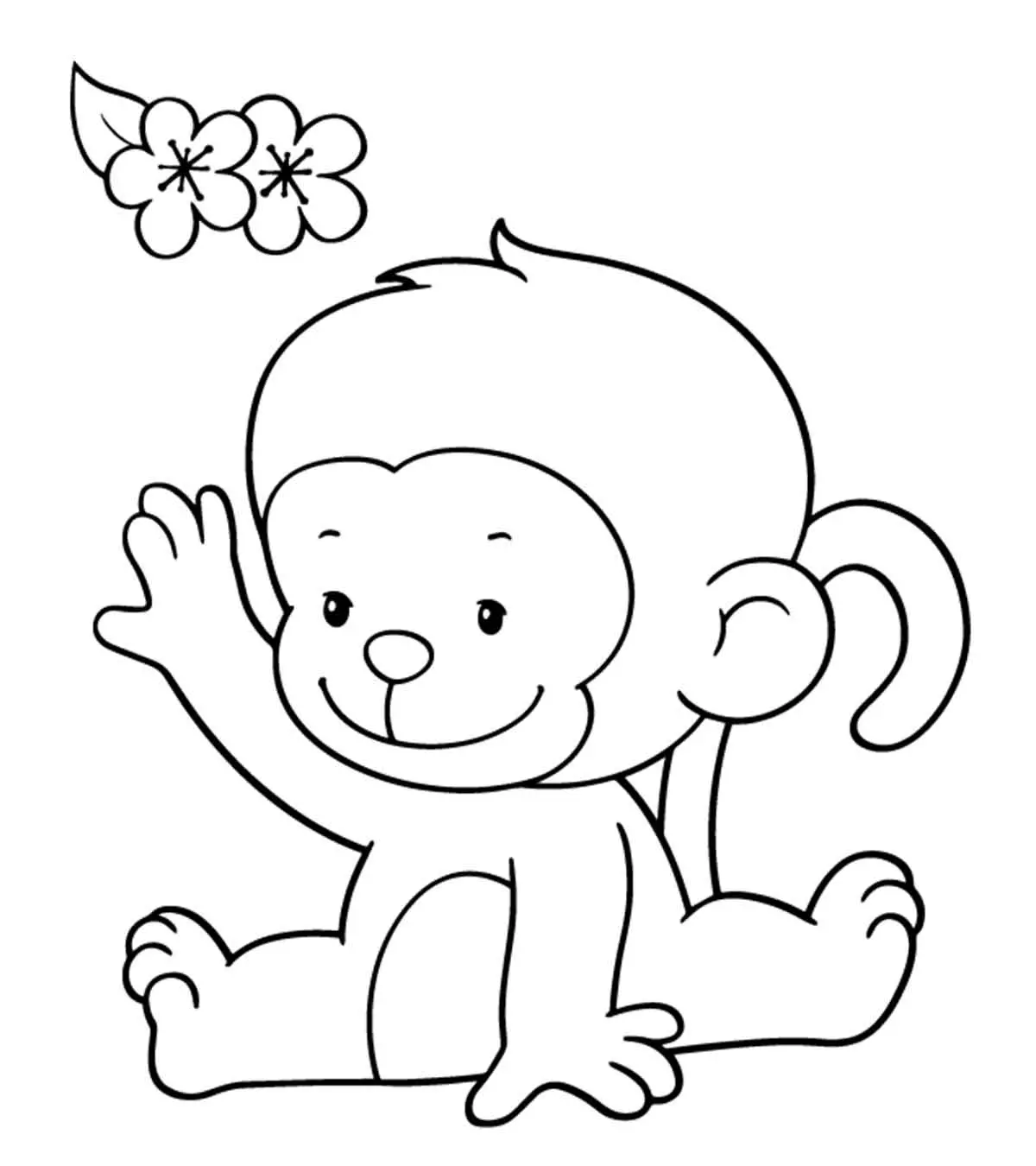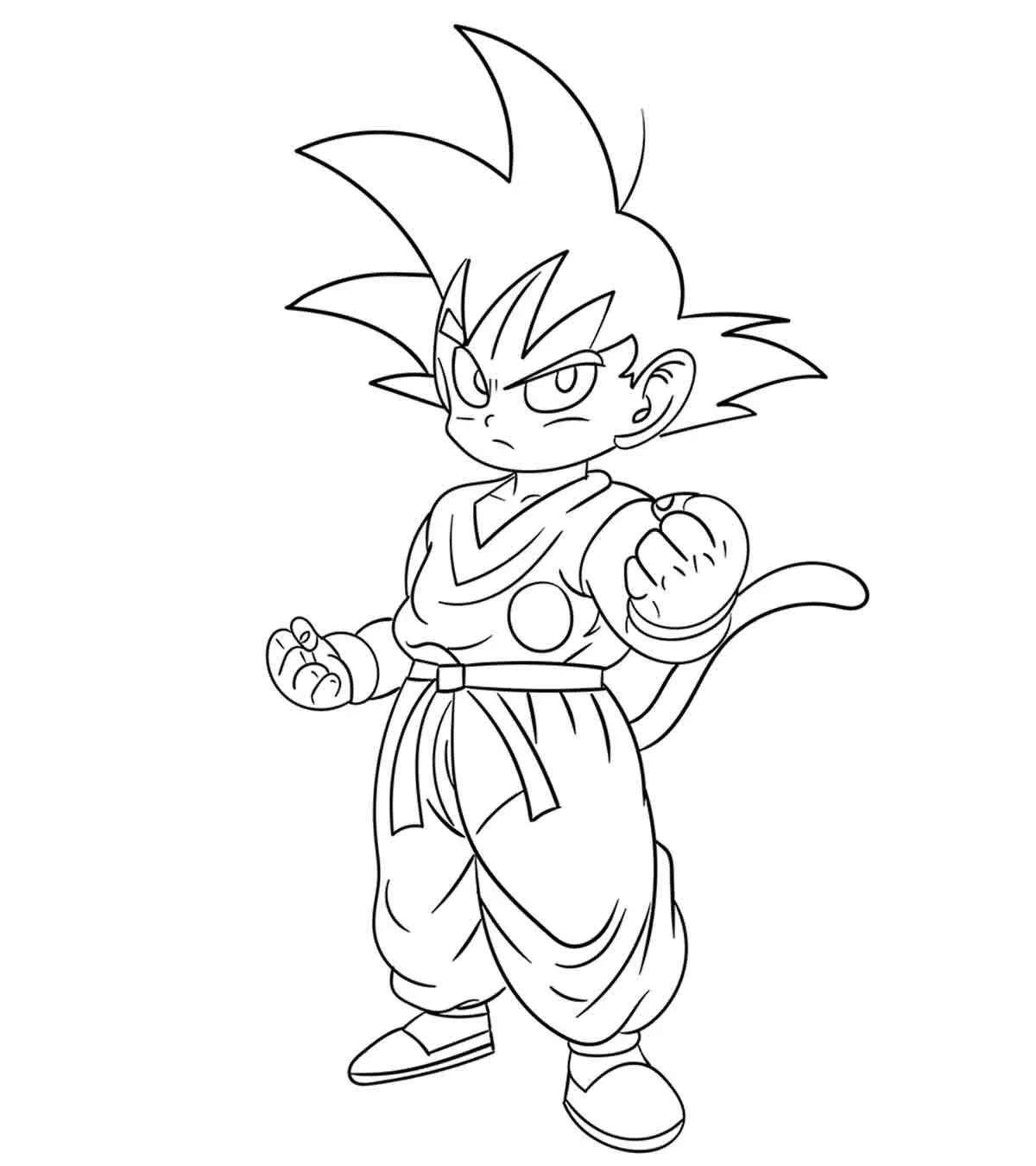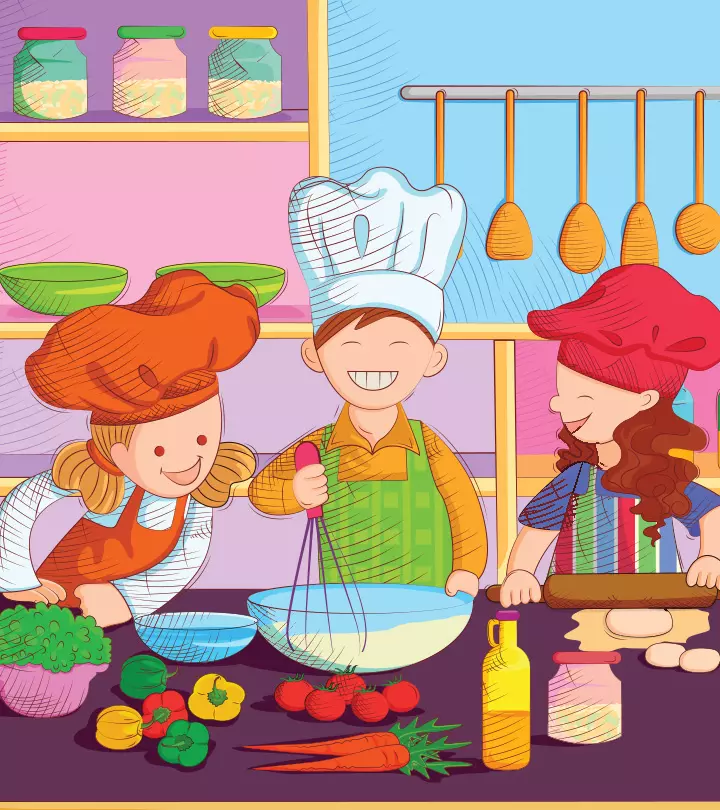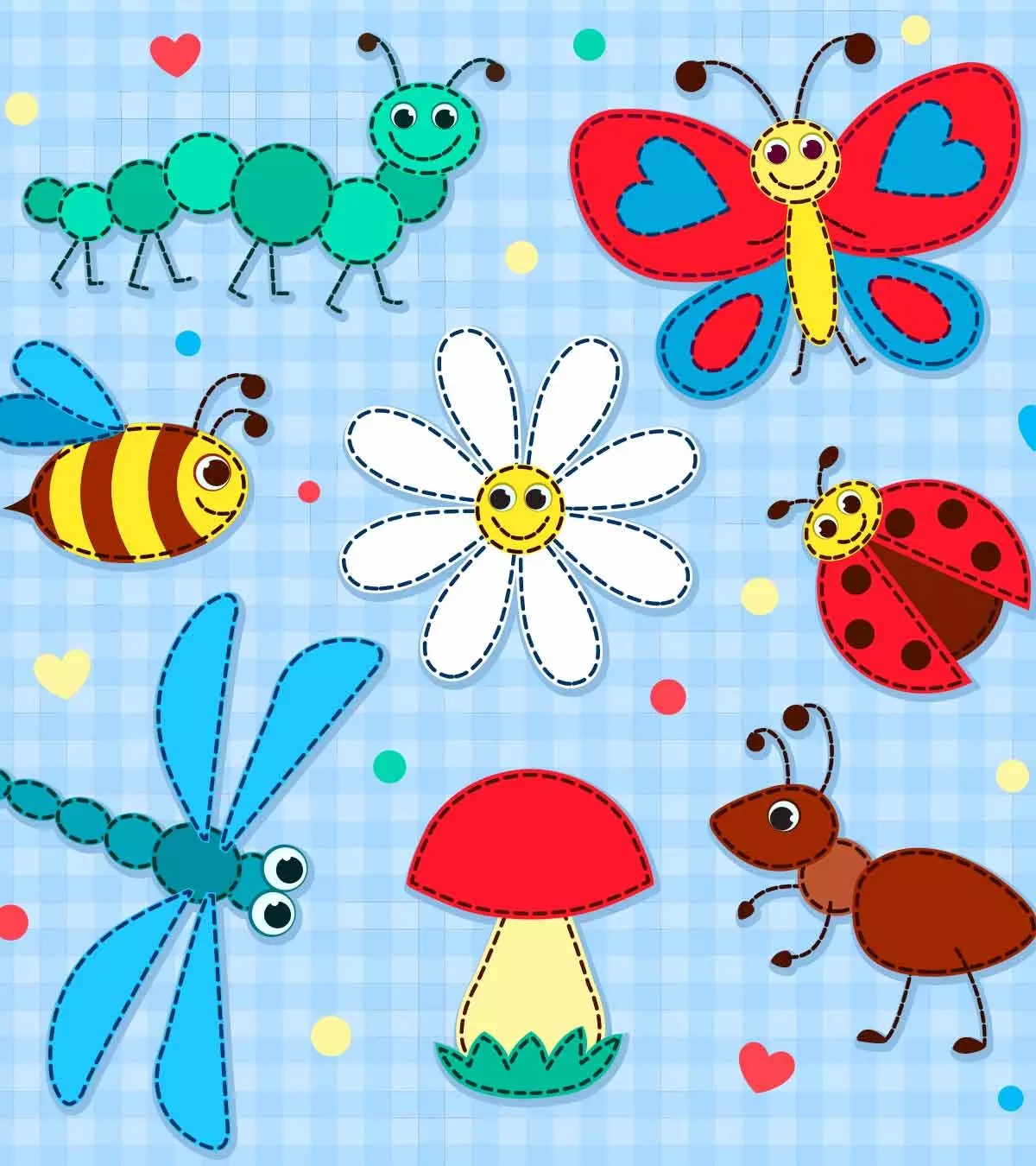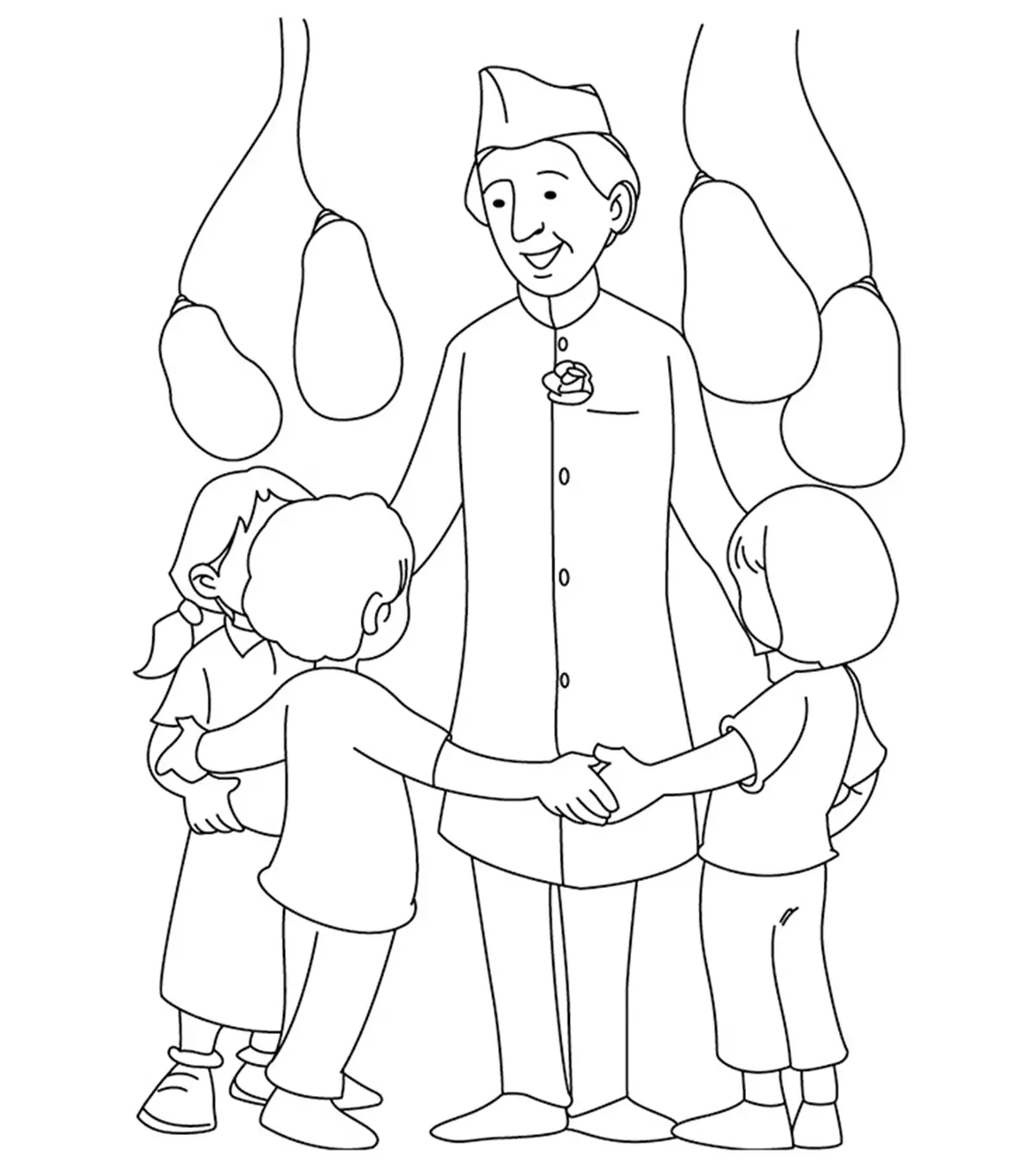
Image: MomJunction Design Team
Educational games not only foster academic skills but also enhance social interaction and critical thinking among teens. Engaging in these activities can significantly boost a teen’s confidence and creativity, making learning enjoyable and impactful. Teachers in middle and high schools frequently engage their pupils in educational games for teens. Parents can do so, too, if their teen enjoys the game.

Here is a collection of fun educational games and activities for teens and preteens to have a fun learning experience.
Key Pointers
- Educational games are used for both fun and learning purposes.
- Games with feedback can help teens learn from their errors.
- Pick an educational game that suits the interests of your teen for more involvement.
- Ensure to keep a tab on your child’s screen time.
What Are Educational Games?
Educational games for teens are based on a variety of subjects like science, math, English, arts, music, and history.
These games engage children and at the same time develop their social, cognitive, and logical skills. The primary objective of these games and activities is to help children learn about different subjects practically.
Teens can also benefit by using learning games to reinforce specific concepts and understand historical events and situations.
Tips For Choosing Educational Games For Teens
Selecting educational games for teens involves a thoughtful approach to ensure engagement and learning. Keep the following tips in mind.
- Opt for games that strike a balance between entertainment and education, preventing boredom.
- Cater to teenagers’ interests and preferences, aligning games with their evolving tastes and areas of curiosity as they transition to young adulthood.
- Offer a mix of challenging and simple learning games. While challenging games can be engaging, simple ones are preferable when teenagers seek a break from academic rigor.
- Prioritize interactive games as they are effective in facilitating meaningful learning experiences.
- Choose games that offer feedback, which is crucial for effective learning by highlighting mistakes and explaining corrections.
- Consider the learning objectives you want your teen to achieve. Tailor the games to target specific subjects or skills such as math, language, or problem-solving, to maximize educational benefits.
Benefits Of Educational Games For Teens
Educational games have become a valuable tool in enhancing the learning experiences of teens. Below are some key benefits of educational games for teenagers:
- Improves engagement: Combines entertainment with education, fostering longer attention spans and better retention of information.
- Develops skills: Enhances critical thinking, problem-solving, and analytical abilities. Encourages teamwork, communication, and collaboration through multiplayer or group-based activities.
- Enhances academic performance: Educational games can positively influence children’s academic achievement and boost their motivation to learn. Through interactive gameplay, children can strengthen important concepts and skills in various subjects (1).
- Boosts creativity: Stimulates imagination through role-playing or strategy-based games, encouraging out-of-the-box thinking.
Educational games provide a multitude of benefits that extend beyond traditional learning. By integrating fun with education, these games foster essential life skills, reduce stress, and keep teens actively engaged in their studies.
27 Best Educational Games For Teens

These games may be used in school or classroom to make the lessons interesting, and also at home when the teens gather to play or do a group study. Here are some of the most engaging educational games for teens that can be used in classrooms and at home to make learning interactive and fun.
1. Name That Tune
Teenagers usually love music. In fact, a study has revealed that kids enjoy listening to music even when they do their school work. They listen to around 10,500 hours of music between seventh and 12th grades, according to Robert A. Cutietta, author of Raising Musical Kids: A Guide For Parents. If your teen is into music, here is an easy educational game that he will love.
Number of participants:
Minimum – 2, Maximum – No Limit
You Will Need:
- A music player
- A collection of songs or an online library of songs.
- Paper and pen for keeping score.
Setup:
- One person can be the moderator while the others will be participants. If you have more than five players, you can form groups and make it a competition.
- You will need at least a couple of hours to compile enough music for the game. Ensure you include pop music and other genres as well.
- The moderator should know the name of the artist and the title of each song.
How to play:
- Moderator randomly picks a song from the collection and plays it for around 10 to 15 seconds.
- Teams or individual participants will be given 30 seconds to come up with the artist’s name and the song’s title.
- If the first team fails, the question passes to the next team. If no team gets it, you can make it a free-for-all question and encourage kids to guess.
- If no one gets the answer right, the moderator reveals the answer.
- You can play as many rounds as you want.
You can create variations of the game by asking participants to identify the genre of music, the instrument that is played and the chord (if the group has knowledge of music).
2. Pictionary
A classic draw-and-guess game, Pictionary lets teenagers explore their drawing and sketching skills
. The game also gives you an understanding of how imaginative they are.
Number of participants:
Minimum – 4, Maximum – 10
You Will Need:
- Board
- Marker or chalk
Setup:
- Divide the participants into teams of two. The game is interesting if there are not more than three teams. More teams can make it a drag. If you have more than ten players, create bigger teams.
- If you have an odd number, one person can be the scorekeeper and also the dedicated timekeeper.
- Prepare strips of paper with the name of an object or event or scene that participants can draw. Think of ideas appropriate for teens like a guitar, college applications, ballet, animals, food items and more.
- You can also include scenarios or events to make the game a little difficult and interesting.
How to play:
- One member of the team has to pick a chit, but not reveal what is written on it to the others.
- He has to use the board and the marker or chalk to draw the object or event for the other team members to guess.
- Players can draw anything that will lead the team members to the right answers – the idea is to encourage imagination and creativity to communicate the right message without talking about it
- If a team is unable to guess the word, the other team gets the chance to score.
- If no one gets the answer right, the moderator reveals it.
- Players can also share their ideas of better and simpler ways to share the message by drawing.
Pictionary is an excellent game that helps develop creative thinking skills and abilities and is entertaining. It is a great way to encourage everyone in the class to test their knowledge. According to Aileen, a travel blogger and TEFL teacher, ”The way I usually play is I split the class into two teams and select a student from each team to come up to the board. I then ask the student to pick one of the new vocabulary words for that day (this usually takes a minute as whatever I suggest they complain it is too difficult to draw, but after a bit of encouragement I usually convince them it’s not so hard). Then the class has to work out what they are drawing and the first team to shout the correct answer gets a point. Using the point system really gets the students engaged in the game. When my students play they play to win and it can get quite competitive (i)!”
3. Making Sentences
Making sentences is a simple yet effective game that develops your teen’s language skills
. The game can last between 30 minutes and an hour.
Number of participants:
Minimum – 2, Maximum – 10
You will need:
- Sheets of paper
Pens
Setup:
This game requires a lot of preparation.
- Look up sentences with words that you want your children to learn.
- Jumble the sentences and start writing down the unique words randomly on the sheet of paper.
- Ensure that the words are spelled correctly and are written clearly so that all the participants understand. Make copies so that each participant gets one.
- Include articles, prepositions, conjunctions and other words that your teen would need to form sentences.
- Make an exhaustive list of sentences that can be created with the words on the paper.
How to play:
- Give your participants a pen, two sheets of blank paper and the sheet with the words.
- Players have to form as many sentences as they can in 30 minutes.
- In the end, the player with the highest number of meaningful and grammatically correct sentences scores the highest.
- You can also form teams of two if you have more people.
Making Sentences is a great game that lets teenagers experiment with language. It makes them think about the different ways a word can be used in a sentence and builds their writing skills.
4. Charades Or Mime Games
Mime games, commonly known as Dumb Charades, can be a lot of fun. Charades are suitable for kids aged eight to 14. It is similar to Pictionary, except that players try to communicate a word or phrase instead of drawing on a board.
Number of participants:
Minimum – 4 Maximum – 10
You will need:
Paper and pen for keeping the score.
Setup:
The teacher or parent can create a list of subject-related words or phrases that your teenager is familiar with. Put the words or phrases on small chits of paper.
How to play:
- Divide the group of kids into different teams of at least two each.
- One person from a group picks a chit but does not read it out loud.
- The player has to enact the word or phrase, and the other member(s) of the team have to guess the word or the phrase.
- The team scores a point if they guess it right.
Shy teenagers may not be willing to participate in this game. Let them be a part of the game, but don’t force them to face the audience unless they are willing to.
5. Monopoly Board Game
Monopoly is one of the most popular fun learning games for teens. The game is about creating wealth and the hindrances that one may face when they try to make money.
Number of participants:
Minimum – 2, Maximum – 6
You will need:
1 Monopoly board game
Setup:
- Read the instructions of the game and make sure you understand everything, should your teenager have any questions about it later.
- Each player gets $1500, divided into different denominations of 500, 100, 50, 20, 10, 5 and 1. The amount and the denominations can vary in different versions of the game.
- The property deeds (cards) and the remaining money are with the bank.
How to play:
- One player has to be the banker and manage the trades that the players want to make. The banker has control of the deeds, the houses and hotels that players can build on their sites.
- The player who gets the highest number on a throw of dice gets to begin the game.
- The number on the set of dice is the number of moves the player has to make on the board.
- If the player lands in a city or area, he or she can buy it from the bank.
- If the roll of dice lands a player in another player’s property, rent is collected by the owner.
- Players can build houses or hotels on the property to collect higher rent from others.
- The game can go on and on for hours or until all players, except one, run out of money
Monopoly introduces your teen to the world of property trading and amassing wealth while overcoming obstructions in the form of taxes, penalties and even jail time.
 Quick tip
Quick tip6. Bird Identification Game
This is a simple, yet an appealing game that encourages teens to learn about the environment and the different species of birds that inhabit it. Therefore, the game is instructive and knowledge-building.
Number of participants:
Minimum – 2, Maximum – 6
You will need:
- Flashcards with pictures of birds
- List of three clues you can give the participants to guess the name of the bird
- Paper and pen for keeping score.
Setup:
- Collect pictures of commonly seen/known birds to bring in fun.
- Include images of birds that your teenager would have learned about at school.
- Keep the list of clues and facts about the bird handy.
How to play:
- Divide the players into teams.
- One person has to be the moderator or the quiz master.
- In every round, each team is shown a flashcard with the image of the bird.
- The image can be displayed on a screen, or it can be passed on to the team that has to identify it.
- The moderator gives the team a chance to guess the name of the bird without clues.
- If needed, he gives one clue at a time, helping the players to guess the name of the bird with as little information as possible.
- Team scores 20 points for identifying the bird without using the clues. They get 15 points if they use one clue, 10 points for two clues and 5 points if they use all the three.
- The game should have at least four rounds so that you get to cover a decent number of birds.
You can create a variation of the game by replacing the pictures of birds with animals.
7. Hangman Word Game
Hangman is a guess-the-word game that can keep your teenagers excited right from the start
. The players have to guess the right word before they exhaust their chances, to score a point.
Number of participants:
Minimum – 2, Maximum – 10
You will need:
- A white board and marker
- Paper and pen for keeping score
Setup:
Prepare a list of words or phrases from a specific subject of your choice.
How to play:
- The moderator or host will pick a word and draw a blank for every letter in the word.
- Players in the team have to guess the possible letters to fill the blanks.
- If they guess a letter right, they guess again and move on until they get the complete word.
- If they guess the letter wrong, the host draws one part of the stick figure of a hanged man.
- The team gets no more chances after the host completes drawing the figure.
This game makes teenagers judicious while using up their chances and guessing the word correctly. Also, you can make the game about any subject – from math, science, environmental science, history, geography to music, art, and movies.
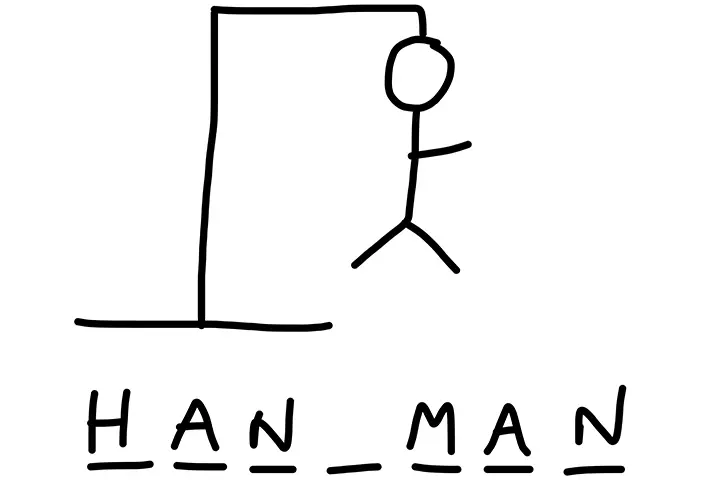
8. Twenty Questions
Twenty Questions is a guessing game, which can be played anytime, anywhere.
Number of participants:
Minimum – 2, Maximum – 12
You will need:
Paper and pen for keeping score.
Setup:
Create a list of famous personalities about whom your child may have learned in history. Use the names of pop or rock music idols, national leaders and other famous personalities in news.
How to play:
- Divide the participants into teams of equal number.
- The host can select one person from the list of names, and the teams have to ask the right kind of questions to narrow their options and guess the name of the personality.
- The team scores a point if they can guess who the person is before they exhaust the 20 questions.
- If the team fails, the other two teams get one chance each to guess who the person is, based on the questions asked.
This stimulating game teaches deductive reasoning and tests the teen’s knowledge of history and current affairs.
9. Silence
Silence is exactly what the game is about. The game is good for large groups and challenges children to accomplish tasks together, but without speaking to each other.
Number of participants:
Minimum – 10, Maximum – NA
You will need:
- Post-its
- Pens
- A lot of space
- Paper for keeping score
Setup:
Some amount of preparation is required for this game.
- Write down the names of months, days of the week or any other set of words that have to be arranged in a particular order.
- Keep the post-its ready and do not mix them up. For example, avoid mixing up the days post-its with months, to avoid confusion during the game.
How to play:
- Pick up a set of post-its on which you have listed down the names, numbers etc.
- Give one sticky note each to one person randomly.
- Make sure that no one has more than one sticky note.
- Once the post-its or sticky notes have been distributed, create space in the front for the activity.
- Tell the players that they have to arrange themselves in the right order in as little time as possible. For example, you say: “the days of the week in the right order or reverse order”, and players with sticky notes with the days of the week should move to the front and arrange themselves in that order.
- The trick is to do it without speaking at all.
There is no competition in this game. However, this game helps children develop organizational, coordination, and non-verbal communication skills.
10. Chain Reaction
Chain reaction is a simple game for building a teenager’s vocabulary.
Number of participants:
Minimum – 10, Maximum – NA
You will need:
- Sheets of paper
- Pens
Setup:
- Pick a topic of your choice – it can be anything appropriate for teenagers like food items, books, names of people, animals, cities, songs, anything from nature or a specific subject like biology, geography or math.
- Tell the topic or theme to the participants; you can write it on the board if it is in a classroom.
- Give the participants sheets of papers and a pen.
- Ask them to write the alphabet A to Z, vertically.
How to play:
- Give your participants five minutes to create an alphabetical list of words relevant to the theme or topic.
- The game begins when the first person reads out a word he or she has written.
- The next person has to give a word beginning with the last letter of the first word.
- The game goes on until all the letters are covered.
- Players unable to give a relevant word are eliminated.
The game can be repeated as many times as you want with different topics. Chain reaction is one of the best ways to make kids remember and recollect everything they have learned.
11. Pass the ball
The goal of this game is not to be the one holding the ball.
Number of participants:
Minimum – 8, Maximum – 12
You will need:
Football or a stuffed-toy ball
Setup:
- Make the participants sit in a circle, with enough space between each other to pass the prop comfortably.
- Select a host or moderator to observe the game and identify ‘It’.
How to play:
- The person holding the ball is ‘It’.
- The host or moderator asks a question and calls out ‘Pass the ball’.
- As soon as the moderator says ‘pass the ball’, ‘It’ should pass the chicken and answer the question before the prop comes back to him. For example, the host calls out “Name five baseball teams. Pass
- the chicken”, the player has to pass the ball and name five teams before the ball comes back to him.
- Other players have to pass the ball while the player answers the question.
- The player holding the ball at the end of the answer becomes the new ‘It’ and faces the moderator’s next question.
- If the prop comes back to the original holder before he or she can answer the question, they continue to be ‘It’.
This game encourages kids to think quickly and answer to dodge the questions by the host.
12. Conversation Game

Conversation is a simple vocabulary game that can be played anywhere. It is an interactive game that teaches them the art of conversation.
Number of participants:
Minimum – 2, Maximum – 10 (5 groups of 2 each)
You will need:
A list of words
Setup:
- Create at least five sets of 10 words each.
- Ask the members of the group to sit facing each other.
- A moderator for timing the activity.
- Paper and pen for keeping score.
How to play:
- Give the players a set of 10 words.
- Tell them to use the words in a conversation.
- Give them 10 seconds to think and one minute to complete the conversation.
- Participants have to use the listed words in a meaningful way.
- If players fail to use all ten words in their one-minute conversation, they don’t score anything.
This game helps to teach kids how words can be used in different contexts in a conversation.
13. Trivia
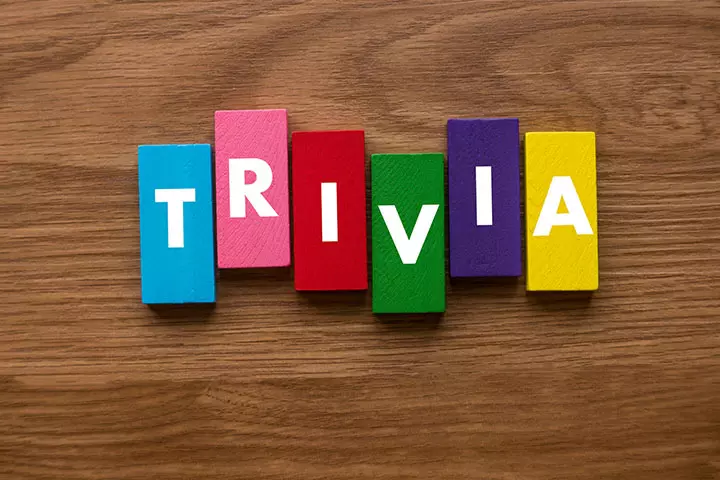
Trivia is an all-time favorite among kids and adults.
Number of participants:
Minimum – 4, Maximum – 8
You will need:
- A set of questions on the chosen topics, along with the right answers and some information about it.
- Paper and pen for keeping score.
Setup:
- Create a list of easy-to-understand questions that your teenager may know the answer to.
- Questions can be from their school subjects, general awareness, current affairs, politics, music or any other topic that your teenager is familiar with.
How to play:
- Form four groups of two.
- The game begins with the host or moderator asking the first team a question.
- If players in the team answer the question correctly, they score a point, and the next team gets to answer a new question.
- But if the team fails to answer the question, it passes on to the other team. The team that answers the question gets the point.
- You can have as many questions as you want.
 Quick tip
Quick tip14. The Human Knot
The Human Knot can be played in your backyard or inside a classroom.
Number of participants:
Minimum – 6, Maximum – 10
You Will Need:
- A timer
- A lot of space for accommodating a circle of people.
Setup:
The game needs a moderator who understands how the Human Knot works and who can guide the participants through the activity. So prep yourself with all that you need to know about the Human Knot and be ready to answer any questions that your teenagers may have.
How to play:
- Arrange the group in a circle.
- As soon as the moderator says go, the children have to join their right hand with that of the person opposite them.
- Then, ask them to join their left hand with someone else’s hand.
- Ensure that they do not hold their neighbor’s hands.
- The objective is for them to untangle the knot without breaking the chain.
The Knot develops the teenager’s problem-solving abilities. It is an excellent game for a field day.
15. Math Quiz
This is a fun way for teenagers to brush their math.
Number of participants:
Minimum – 4, Maximum – 8
You will need:
- A set of questions from math.
- Paper and pen for keeping score.
Setup:
- Collect math and quantitative aptitude questions.
- Make sure that the questions are clear and easy to understand.
- Try to include real life scenarios in the questions to make it relevant.
How to play:
- Math Quiz is similar to trivia, except that it is dedicated to quantitative abilities.
- Ask the teams a question and let everyone work on the problem.
- Give the teams at least one minute to come up with the answer.
The idea is to encourage teenagers to rely on their quantitative abilities instead of using electronic calculators.
16. Escape Room Challenge
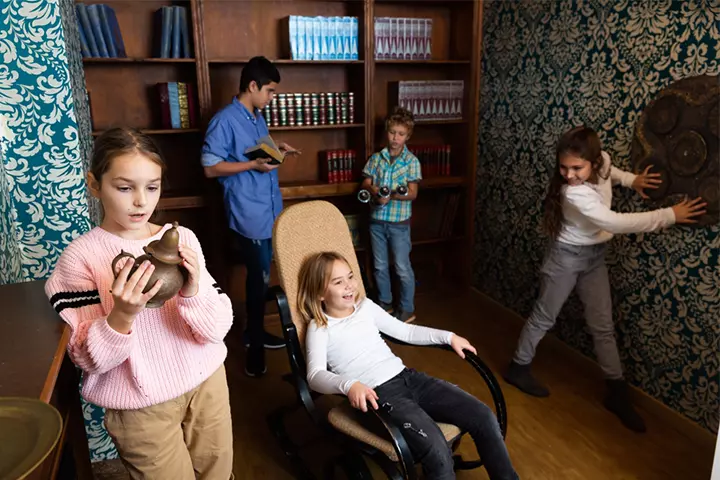
Escape Room Challenge is an immersive problem-solving game where teens solve puzzles to “escape” from a locked room scenario.
Number of participants:
- Minimum – 4, Maximum – No limit
You will need:
- Escape room kit or set of puzzles and clues
Setup:
- Set up the escape room with puzzles and clues around the room.
What to do:
- Divide participants into teams.
- Lock the team in the room and give them the first clue.
- Teams must solve the puzzles and follow the clues to escape the room within a set time limit.
- The team that escapes the quickest or solves the most puzzles wins.
17. Language Launcher
It is a competitive game where teens practice foreign languages through fun and interactive challenges.
Number of players:
Minimum – 2, Maximum – 30
Setup:
- Prepare cards with language tasks, such as translating phrases, constructing sentences, or identifying objects in the language.
- Arrange activity stations for different languages based on participants’ preferences or school curriculum.
How to play:
- Participants draw cards and complete tasks to earn points.
- Challenges increase in difficulty as the game progresses.
- The participant with the most points after all rounds wins.
18. Civic Heroes
Civic Heroes is a role-playing game where teens act as city council members addressing real-life community issues.
Number of players: Minimum – 3, Maximum – 15
Setup:
- Prepare briefs on community issues such as zoning laws, public health, or education.
- Set up a mock council chamber for debates.
How to play:
- Participants choose or are assigned roles as council members, citizens, or interest group representatives.
- They discuss and debate issues, propose solutions, and vote on measures.
- Points are awarded for effective communication, problem-solving, and resolution outcomes.
19. Code Quest

Teens engage in coding challenges to solve puzzles and build simple applications.
Number of players: Minimum – 2, Maximum – 15
Setup:
- Provide computers with access to coding platforms like Scratch or Python.
- Prepare coding challenges suitable for various skill levels.
How to play:
- Introduce the basics of coding syntax and logic.
- Assign coding challenges that participants must solve within a timeframe.
- Review and discuss each solution as a group.
20. Chess
Chess is a world-renowned interactive board game where teenagers learn strategies and hone their skills.
Number of players: Minimum – 2, Maximum – 20
Setup:
- Arrange chess boards and pieces for each participant.
- Prepare a presentation on different chess strategies.
How to play:
- Begin with a brief lecture on a specific chess strategy.
- Participants practice the strategy in pairs.
- Host a mini-tournament to apply the strategies in real games.
21. Guess That Movie
In a creative and fun twist on charades, Guess That Movie has teams re-enact scenes from films. It’s a test of acting skills and movie knowledge.
Number of Players: 4-24
Setup:
- Divide a larger group into smaller teams of 4-6 people.
- No special equipment is needed.
How to play:
- Each team picks a movie scene to re-enact secretly.
- Teams perform their chosen scene in front of the group within a 3-minute limit.
- Other teams try to guess the movie based on the scene.
- Points are awarded for each correct guess, and the team with the most points wins.
22. Blindfold Trust Walk
It is an engaging game focusing on communication, trust, and teamwork. Participants must guide their blindfolded teammates through an obstacle course using only voice commands while avoiding misinformation from opponents.
Number of Players: 4-20
Setup:
- Arrange chairs in a room to create an obstacle course.
- Split the group into two equal teams.
- Provide a blindfold (bandana) for each team.
How to play:
- Blindfold one player from each team and spin them around 2-3 times.
- Teams must guide their blindfolded member through the course using only voice directions.
- The opposing team may give false directions to confuse the player.
- The first blindfolded player to finish scores a point. If they touch a chair, they’re out.
- The game continues until a team scores 5 points, rotating the blindfold among team members.
23. Science Trivia
Science Trivia is a fun and interesting way to test and expand knowledge in various scientific fields, such as biology, chemistry, physics, and earth science.
Number of participants:
- Minimum – 2, Maximum – No limit
You will need:
- A list of science questions
- Paper and pen for keeping scores
Setup:
- Prepare a list of science questions covering topics based on the teens’ reading levels and age.
How to play:
- Divide participants into teams.
- The moderator asks a science question to one team.
- The team has 30 seconds to answer.
- Correct answers earn points. If a team cannot answer, the question passes to the next team.
- The team with the most points wins.
24. Word Association Game
Word association is a fun game that stimulates creative thinking and quick responses. It’s perfect for developing vocabulary and improving language skills.
Number of participants:
- Minimum – 2, Maximum – No limit
You will need:
- Paper and pen for keeping score
Setup:
- No setup is required. This game can be played anywhere.
What to do:
- One player says a word, and the next player quickly follows with the first associated word that comes to their mind.
- Continue around the circle, with each player responding to the last word said.
- If a player takes longer than 3 seconds to answer or repeats a word, they are out.
- The last remaining player is the winner.
- You can introduce a variety of themes, such as animals, food, etc, to make the game more challenging.
25. Geography Bee

Geography Bee is a trivia game that tests players’ knowledge of world geography. It’s great for learning about different countries, capitals, geographical features, and landmarks.
Number of participants:
- Minimum – 2, Maximum – No limit
You will need:
- A world map
- List of geography questions
- Paper and pen for keeping score
Setup:
- Prepare a list of geography-related questions and answers.
What to do:
- Divide participants into teams.
- The moderator asks a geography question to one team.
- The team has 30 seconds to discuss and answer.
- If they answer correctly, they score a point. If not, the question passes to the next team.
- The team with the most points at the end of the game wins.
26. Story Cubes
Story Cubes is a creative storytelling game that helps teens develop their imagination and narrative skills.
Number of participants:
- Minimum – 2, Maximum – No limit
You will need:
- A set of story cubes or dice with pictures
Setup:
- No setup is required. Just ensure each participant can see the cubes.
What to do:
- Roll all the story cubes.
- Each participant takes turns creating a part of a story based on the images shown on the cubes.
- The next participant continues the story with the next cube, and so on.
- The game continues until all the cubes are used, creating a complete story.
- This game can be played multiple times with different story outcomes each time.
27. Debate Club
Debate Club is a structured argumentation game that helps teens practice public speaking, critical thinking, and reasoning skills.
Number of participants:
- Minimum – 4, Maximum – No limit
You will need:
- Debate topics
- Timer
- Paper and pen for notes
Setup:
- Choose debate topics relevant to the participants’ interests.
What to do:
- Divide participants into two teams: one for and one against the topic.
- Each team gets 5 minutes to prepare their arguments.
- Each speaker from both teams presents their arguments for 2 minutes.
- After all speakers have presented, teams get 2 minutes to prepare rebuttals.
- Each team then presents their rebuttals.
- A neutral judge or the audience decides the winning team based on the strength of arguments and presentation skills.
Online Educational Games

Teenagers can also play a variety of educational games online. From something as simple as trivia on different subjects to crosswords and complicated simulation games, there are hundreds of online educational games for teens.
28. Climate Challenge
Climate Challenge is an online educational game designed by the BBC. The focus of the game is climate change, which is a major cause for concern for world nations. The game’s tagline is “Earth’s future is in your hands”, which gives children a sense of responsibility and makes them aware of their role.
You will need:
- A computer or laptop
- Internet connection
- Flash Player 8 installed on your system
Setup:
No setup is required for this game. Your teen can play Climate Challenge here.
How to play:
- The player has to don the role of the president of the European Union and figure out ways to deal with catastrophic events that are threatening the global climate.
- The game has policy cards which are taken from real policies for minimizing carbon dioxide emissions. The statistics used in the game are also taken from actual records.
- While tackling man-made and natural disasters that may or may not affect the climate, the player should also implement or change policies to stay popular among the nations and citizens.
- The game is challenging in the sense that the player has to strike a balance between doing what is good for the environment and also addressing the voter’s needs.
The game includes details from real-life studies wherever possible, but is not necessarily an accurate prediction of how the climate is going to change. Nevertheless, it is a great online game that introduces young adults to the hottest and thought-provoking topics among environmental scientists: climate change and why it is bad.
29. Operate Now: Arm Surgery 2
Does your teen show a keen interest in medicine? Then he may enjoy Operate Now: Arm Surgery 2. The interactive game takes the player through the many steps involved in fixing a broken arm.
You will need:
- A computer or laptop
- Internet connection
Setup:
No setup is required for this game. Your teen can play Climate Challenge online.
How to play:
- It is your first day at the hospital and the head nurse greets you.
- Throughout the game, the player interacts with the head nurse to answer questions, select the right tools and diagnostic procedures to treat a patient with a broken arm.
- The game does not show the actual procedure performed by doctors, but tells you enough to understand how a surgeon fixes a broken arm.
Arm Surgery 2 can be played on a number of online gaming sites. The game is simple, fun and gives you an idea of what happens behind the scenes during an arm surgery.
30. Minecraft
As one of the most instructive video games for youngsters, Minecraft is also the best-selling game ever. Nothing can stop players in this sandbox game from creating anything they can dream up except a lack of imagination. Playing the game Minecraft encourages kids to explore, experiment, and be curious.
You will need:
- A computer, console, or mobile device
- Internet connection (for multiplayer and updates)
Setup:
- Download and install Minecraft from your device’s app store or official website.
- Create or sign in to your account.
How to play:
- Select the Creative or Survival mode when the game launches.
- Manage your hunger and health while gathering materials, making tools, and constructing shelters in survival mode.
- Use as many materials as you like to build and explore in Creative mode.
- The game mechanics teach kids about construction materials, engineering principles, and even rudimentary coding.
- Investigate the multiplayer alternatives to work on large-scale projects with friends.
31. Kerbal Space Program
In the rocket simulator game, users assume control of the space program for Kerbals, an extraterrestrial race. The game teaches actual engineering topics like fuel efficiency, thrust, and airflow by emphasizing trial and error in the construction and testing of rockets.
You will need:
- A computer or console
- Internet connection (for updates and community resources)
Setup:
- Purchase and install the game from your platform’s store or the official website.
- Ensure your system meets the game’s requirements.
How to play:
- Begin the game by designing a rocket in the Vehicle Assembly Building
- When testing your rocket, focus on factors like thrust, stability, and fuel economy.
- Take on expeditions to investigate different celestial entities and learn from your successes and failures.
- To grasp space travel concepts, such as orbits and docking maneuvers, apply realistic physics.
32. Math Blaster
Early teen children can enjoy playing the educational game called Math Blaster. Math principles such as addition, subtraction, multiplication, division, decimals, place value, money, angle kinds, and multiples are extensively covered in this entertaining minigame-style educational game.
You will need:
- A computer or mobile device
- Internet connection (for updates and online play)
Setup:
- Download and install Math Blaster from the app store or official website.
- Create an account or sign in.
How to play:
- Select from a variety of minigames and math problems.
- To advance in the game and unlock new levels and rewards, solve arithmetic problems.
- Monitor development and modify difficulty to correspond with the child’s level of learning.
- To keep students interested and reinforce arithmetic concepts, use engaging and dynamic graphics.
33. BodyQuest
If you want to teach the anatomy of the human body to teens in a fun way, look no further. The BodyQuest is an entertaining educational game where the players must repel an army of invading aliens, while also learning various parts of the human body.
You will need:
- A Nintendo Switch console
- Internet connection (for updates and multiplayer)
Setup:
- Purchase and install BodyQuest from the Nintendo eShop.
- Ensure your console is updated to the latest firmware.
How to play:
- Launch the game and navigate your avatar through the various human bodily sections as you follow the plot.
- While completing assignments, learn about numerous organs, systems, and their operations.
- Play engaging mini-games that help you remember the anatomical concepts.
- To get over obstacles and move, use the game’s hints and tips.
34. The Oregon Trail: American Settler
The Oregon Trail: American Settler is a follow-up to the beloved Oregon Trail, a popular simulation game about world creation. Children nine years and older can explore historical facts and figures while learning about pioneer life on the American frontier.
You will need:
- A smartphone or tablet
- Internet connection (for updates and online features)
Setup:
- Download and install the game from the App Store or Google Play.
- Ensure your device meets the game’s requirements.
How to play:
- Set up your settlement first, taking care of supplies like food and building materials.
- Completing missions that depict historical occurrences and pioneer life will help you advance the plot.
- Through engaging gameplay and character interactions, discover a variety of topics related to American history.
- Grow your community, engage in trade with other players, and deal with issues like resource scarcity and natural calamities.
Top 16 Educational Activities For Teens
In addition to games, educational activities and little experiments can be used to make learning fun for teenagers.
35. Geometry Scavenger Hunt
Geometry is not an easy subject to love. If you want to get your teenager interested in it, the Geometry Scavenger Hunt is a skill-building activity you can rely on.
You will need:
- A camera per person/teen.
- List of geometric shapes, terms for each participant.
Setup:
- Give clear instructions to the children about their objective.
- Emphasize the importance of following instructions to achieve the objective.
What to do:
- Math Quiz is similar to trivia, except that it is dedicated to quantitative abilities
- Ask the teams a question and let everyone work on the problem
- Give the teams at least one minute to work on the problem and come up with the answer
- If a team can’t answer, the question passes to another team.
36. Record The Natural World
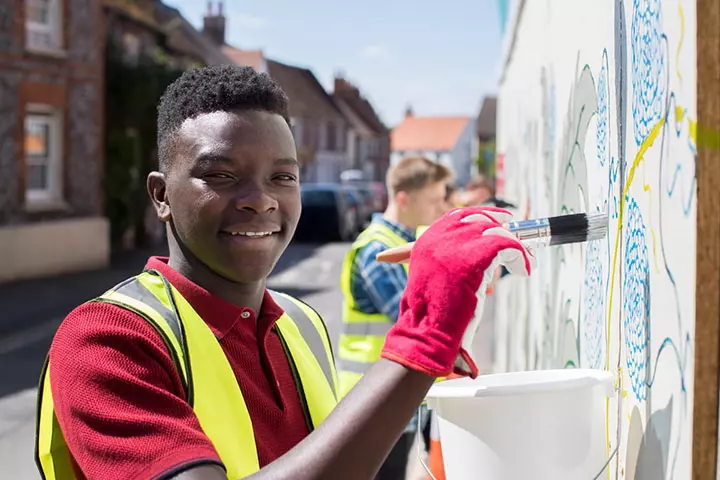
Worried that your teenager is playing too many video games? Here is an enlightening activity that will encourage him to go outdoors and explore the wonders of nature.
You will need:
- Watercolor paper.
- Water colors.
- Pencils for drawing.
- Eraser and sharpener.
- Specimens like leaves, flowers, trees, bushes, etc. that they can see and draw.
- Containers for water colors.
Setup:
- On the drawing paper, write down the name of the specimen, date, and classification for reference.
- You may want to take your teen to a park or a garden where he can take a close look at the specimen and reproduce it on paper.
What to do:
- Ask the kid to look at the specimens closely and make a note of the details – the lines, the number of branches, the geometric shapes, the color and the texture.
- Ask him to create a rough outline of the specimen first and then move on to the finer details.
- Give them enough time to do that – may need an hour or more.
- Once they are done with the drawing, they can use the water colors to give them the natural colors.
This activity can create an interest in nature and also encourage them to develop their sketching and painting skills. If you think your teen will like this game, there are several other outdoor games for teens that will provide them more fun and learning experiences.
37. CSI: Get The Fingerprints
If your teenager is into solving mysteries, he or she will love this engaging activity. It teaches them the simplest ways to get fingerprints from anything.
You Will Need:
- Pencil
- Clear tape
- Cornstarch or talcum powder
- Piece of white paper or index card
- Makeup brush or paint brush
- One drinking glass
- Magnifying glass
- Cocoa powder
Setup:
Let your teen use household objects and areas for this little project.
What to do:
- The easiest way to get someone’s fingerprints is to rub the pencil over one part of the white paper and use it as a stamp pad. Press your fingers on the pencil stamp-pad and then on a white paper or an index card to read the prints.
- Take a drinking glass or any other object with your fingerprints. Make sure you have used it a few hours or a day before.
- Ask your teenager to use a magnifying glass to find and look at the fingerprints and research online about what makes them unique.
- They can also dust for fingerprints, as they do in movies and TV shows, using powders. Sprinkle a little cornstarch or talcum powder if the surface is dark and cocoa powder if the surface is light-colored. Blow off the excess powder or use a brush to dust it off to see the fingerprints clearly.
- Your teen can also peel off the fingerprint using a clear tape and paste it on an index card or white paper.
This is an interesting mind-bending activity that introduces forensics to your teenager.
38. Physics Made Fun With Cartoons
Help your teenager learn the laws of physics with this fun game.
You will need:
- TV
- Cartoon shows
- Stopwatch
- Calculator
Setup:
- This activity can be conducted right in your living room.
- Create a list of physics concepts that your teen may have learned in school.
- You will have to be familiar with the laws of physics that you want to discuss with your child.
- Road Runner and Looney Toons are ideal for this activity.
What to do:
- Select the concepts that your child has learned at school.
- Watch a few cartoons together and ask your teenager what laws of physics have been applied in the cartoon character’s actions.
- Discuss what is real and what has been exaggerated.
- See if your teen can calculate a different variable based on the physics equations they have learned at school. For example, ask the teen to time Daffy Duck’s or Will E Coyote’s fall from a cliff. And then ask them if they can derive the distance based on the time it took them to fall.
This exercise can be great to brush up basic formulas of physics, which your teen is likely to learn in middle and high school.
39. The Monty Hall Problem
The Monty Hall Problem teaches your kid about probability.
You will need:
- Sheets of paper with the problem
- Pens
Setup:
- This activity can be conducted at school or home.
- Ideal for groups as it allows for debate.
- The host or moderator should have a good understanding of the problem to be able to explain it to the kids.
What to do:
- Give them the Monty Hall Problem on a sheet of paper. You can get it online.
- Tell the kids that there are three doors and only one of them has a car behind it.
- Ask them what the probability is of getting the car. The answer should be 1/3.
- Now tell them there is a goat behind the first door.
- Ask them the probability of picking a door with the car behind it. They should say that it is 2/3, which means they have a better chance of winning in this round.
Children may say that the probability of picking the right door the second time is ½, which is wrong. This is a good example to help them understand the concept.
40. Trace The Shadow
This is a fun game that can be played outside. The game is about the movement of light, usually sun, and how the position changes the angle in which the shadow falls.
You Will Need:
- A plastic bottle – should not be transparent
- Sheets of paper
- Pencil
Setup:
This activity can be conducted only on a sunny day.
What to do:
- Place the sheet of paper on a table or a bench in the park on a sunny day.
- Place the bottle in the center of the sheet and ask your teen to trace the shadow of the bottle with a pencil.
- Do the same after a couple of hours, with the paper and the bottle in the same position. This time, the shadow falls on a different part of the paper.
- Do this three or more times – this will enable your kid to tell where the sun is, based on the shadow of the bottle.
- Make a note of the time each time the child traces the shadow.
This is a simple, yet effective way to help your child determine what time of the day it is based on the position of the sun and where the shadow falls.
41. Book Club

Book Club encourages teens to read and discuss books, enhancing their comprehension and critical thinking skills.
Number of participants:
- Minimum – 2, Maximum – No limit
You will need:
- A selected book for all participants
- Discussion questions
Setup:
- Choose a book that everyone will read.
How to play:
- Give participants time to read the book.
- Meet regularly to discuss chapters or sections of the book.
- Use discussion questions to guide the conversation.
- Each participant can take turns leading the discussion.
42. Poetry Slam
Poetry Slam is a creative activity where teens write and perform their own poetry as a fun outlet for their creativity and improving their public speaking skills.
Number of players:
- Minimum – 2, Maximum – No limit
You will need:
- Paper and pen
- Microphone (optional)
Setup:
- No setup is needed. Just make sure there is a comfortable space for participants to perform.
How to play:
- Give participants time to write their poems.
- Each participant takes turns performing their poem in front of the group.
- Optionally, participants can judge each other’s performances based on creativity, delivery, and content.
- The participant with the highest score wins.
43. Bake-off Challenge
Participants compete to create the best dish using a set list of ingredients. This activity is a great way to introduce teenagers to the art of baking.
Number of players:
Minimum – 2, Maximum – 10
Setup:
- Prepare kitchen stations with identical sets of ingredients and baking tools.
- Ensure a working oven and cooking essentials are available.
How to play:
- Reveal a theme or specific dish to be baked.
- Participants have a set time to plan, prepare, and bake their creations.
- Judges score dishes based on taste, presentation, and creativity.
44. Green Thumb Club
A gardening activity where teens learn about sustainable gardening practices and cultivate their plants.
Number of players: Minimum – 3, Maximum – 20
Setup:
- Allocate garden plots or containers for each participant.
- Provide seeds, soil, gardening tools, and instructional materials.
How to play:
- Teach basic gardening techniques and sustainable practices.
- Each participant plants and maintains their garden.
- Monitor progress and hold discussions on improvements and care.
45. Capture The Moment

A photography activity where teens learn about photography techniques and compete by capturing photos based on themes.
Number of players: Minimum – 2, Maximum – 15
Setup:
- Provide digital cameras or smartphones with cameras.
- Prepare a list of themes or subjects to photograph.
How to play:
- Introduce basic photography skills like lighting, angles, and composition.
- Assign a theme for the photography session.
- Participants submit their best photos, which are judged on creativity and technique.
46. Craftsmanship Workshop
With a craftsmanship workshop, teens learn woodworking and handicraft skills to create personal projects from wood or other materials.
Number of players: Minimum – 2, Maximum – 10
Setup:
- Set up workstations with necessary tools and safety equipment.
- Provide raw materials such as wood, nails, glue, etc.
How to play:
- Teach basic woodworking and safety procedures.
- Guide participants through a simple project, like building a birdhouse.
- Allow creativity in decorating or modifying their projects.
47. Pottery Hands-On
A creative workshop where teens learn the art of pottery making, including wheel throwing and sculpting.
Number of players: Minimum – 2, Maximum – 10
Setup:
- Equip a space with pottery wheels, clay, and sculpting tools.
- Prepare stations for each participant.
How to play:
- Demonstrate basic techniques like wedging, centering clay, and wheel throwing.
- Participants create their pottery items.
- Discuss and display finished products after firing.
48. Volunteer Heroes
Volunteer Heroes is a role-playing real-life simulation where teens participate in planned volunteering activities to support local communities.
Number of players: Minimum – 5, Maximum – No Limit
Setup:
- Coordinate with local organizations for volunteer opportunities.
- Prepare a schedule and roles for participants.
How to play:
- Participants are briefed on their roles and the goals of the activity.
- Engage in volunteering tasks, such as cleaning up parks or assisting at community centers.
- Reflect on the experience and discuss the impact of their contributions.
49. Stargazers Club
It is an astronomy workshop where teens learn about constellations, planets, and asteroids, and use telescopes to view celestial events.
Number of players:
- Minimum – 2, Maximum – 20
Setup:
- Provide telescopes and star maps for each participant.
- Choose a location away from city lights for better visibility.
How to play:
- Introduce basic concepts of astronomy.
- Guide participants on how to use telescopes and identify celestial bodies.
- Organize viewings of meteor showers or planetary alignments.
50. Docu-Quest
In the Docu-Quest, teens watch educational documentaries on various subjects and participate in discussions and quizzes about the content.
Number of players: Minimum – 2, Maximum – 30
Setup:
- Set up a viewing area with a screen and comfortable seating.
- Select documentaries that are engaging and informative.
How to play:
- Watch a documentary together.
- Host a quiz or discussion session on the key points and messages.
- Encourage critical thinking and debate on the topics covered.
Frequently Asked Questions
1. What are the academic problems faced by teenagers?
It is quite common for teens to experience academic issues during adolescence. These academic issues may include bad study habits, trouble understanding the subject, test anxiety that results in poor exam performance, procrastination on assignments, difficulty organizing one’s time to accomplish assignments or study chores, and irregular attendance in class.
2. What is the role of education in adolescent behavior?
Education plays a crucial role in shaping adolescents’ attitudes, values, knowledge, and skills, promoting personal and social development while preparing them for future opportunities.
3. What are the potential drawbacks of educational games for teens?
Despite the advantages, educational games for teenagers may have drawbacks too. If the game content fails to captivate and align with the teens’ interests, it may result in disengagement. These games may become the sole means of learning. Moreover, teens may be unable to balance their screen time with other activities like physical exercise and social interactions.
4. What are some of the challenges associated with using educational games for teens?
Introducing educational games for teens can pose certain difficulties. These may include the limited availability of high-quality educational games, the need to ensure the games are both captivating and in line with desired learning outcomes, and assessing the games’ effectiveness in fostering meaningful learning.
5. What educational games are best for enhancing learning among teens?
The most effective educational games for enhancing learning incorporate competition and collaboration. Such games engage students by encouraging teamwork and fostering critical thinking while making the learning experience enjoyable. Competitive elements motivate students to challenge themselves and each other, to improve their skills. At the same time, collaborative aspects promote cooperation and communication, helping students work together to solve problems and achieve common goals. This balance of friendly competition and teamwork keeps the learning process fun and reinforces vital academic concepts.
Making education fun can help engage teenagers in studies. Educational games for teenagers help them develop several essential skills. These activities will help your teen get excited about learning. If teenagers find something that interests them, they will dig up the subject until they know all about it. So, go through this list of interesting educational games and pick the one that best fits your teen’s interests.
Infographic: Best Educational Games For Teens To Play
Teenagers are hard to please and can easily get bored. You may include games and activities in their schedule that are fun and promote learning. The infographic below includes some of the best games they can enjoy. Keep reading!
Some thing wrong with infographic shortcode. please verify shortcode syntax
Illustration: Popular Educational Games For Teens
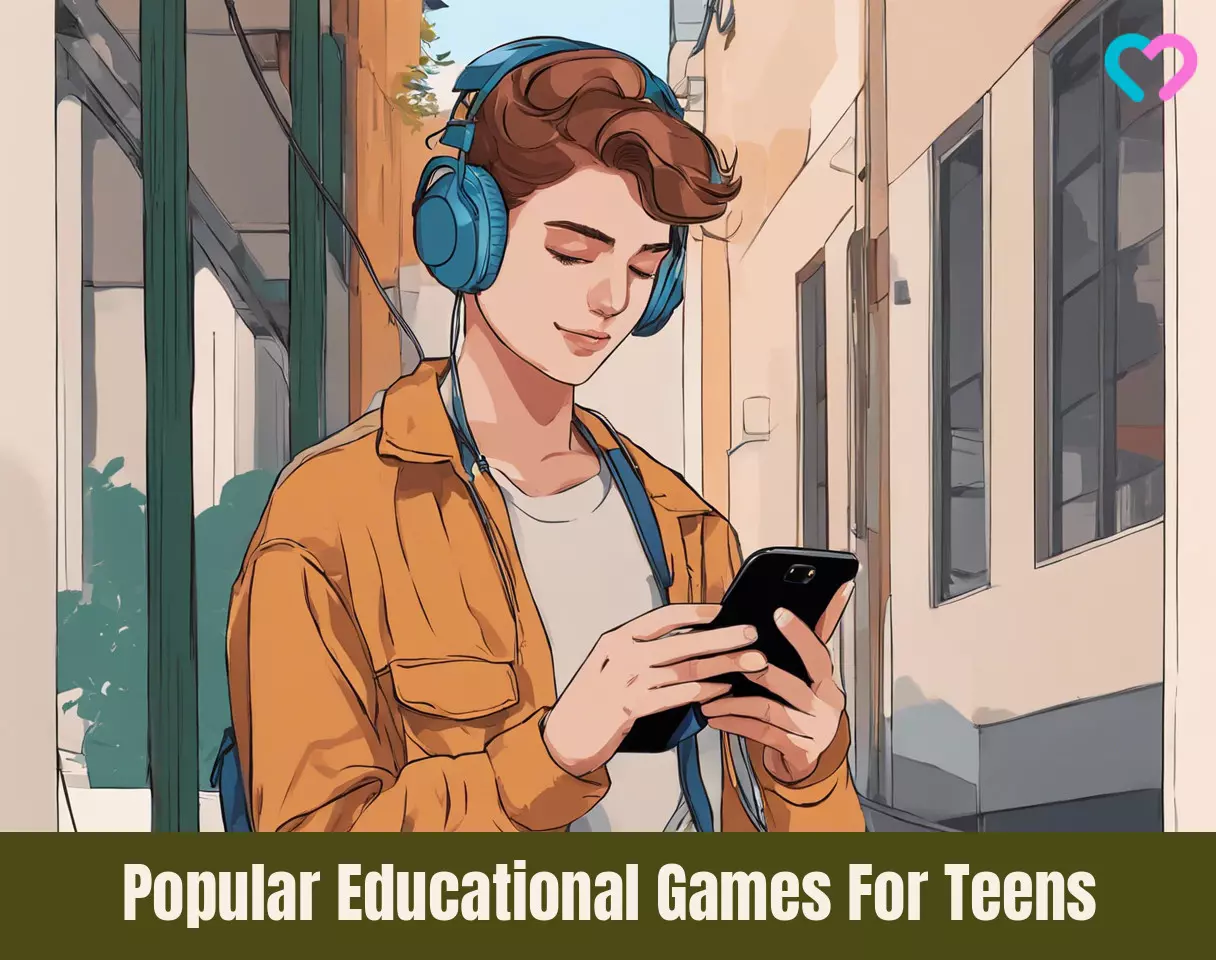
Image: Stable Diffusion/MomJunction Design Team
Personal Experience: Source
MomJunction articles include first-hand experiences to provide you with better insights through real-life narratives. Here are the sources of personal accounts referenced in this article.
i. TEFL Tip Tuesday: The Power of Pictionary.https://welltravelledlass.com/2019/01/29/tefl-tip-tuesday-the-power-of-pictionary/
References
- The Benefits Of Educational Games For Children.
https://www.sparxservices.org/blog/educational-games-for-children
Community Experiences
Join the conversation and become a part of our nurturing community! Share your stories, experiences, and insights to connect with fellow parents.
Read full bio of Elisa Yi
Read full bio of Harshita Makvana
Read full bio of Deepa Thomas
Read full bio of Nisha Bharatan






